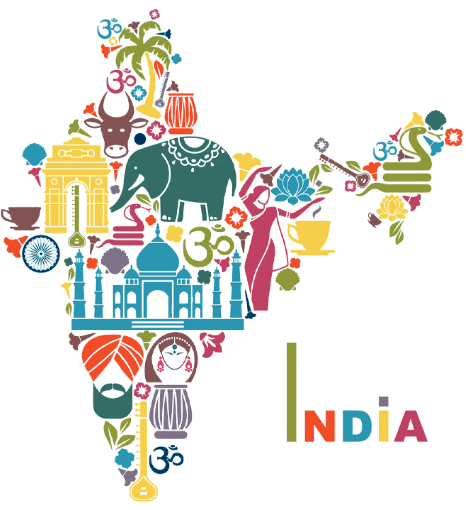Unity in Diversity Chapter Notes | Communicative English for Class 10 PDF Download
| Table of contents |

|
| Key Points of the Story |

|
| Detailed Summary |

|
| Theme/ Message |

|
| Difficult Words |

|
Key Points of the Story
- Rohan and Rajni are two friends who travel across India from different starting points.
- Rohan starts his journey in Gujarat, which is in the west, while Rajni begins in Kashmir, located in the north.
- As they travel, they visit many states, including Mizoram in the northeast and Tamil Nadu in the south.
- During their journey, they observe the diverse cultures, languages, and traditions that each region offers.
- They notice the beautiful landscapes and rich histories of the places they visit, which make them feel amazed.
- Festivals play a big role in their experiences, as they see people celebrating different occasions with joy.
- They feel a strong emotional connection to the people they meet and the places they visit.
- Despite the differences in culture and customs, Rohan and Rajni understand that there is a unifying identity among all Indians.
- They learn that India is like a tapestry made up of various threads, where each thread represents a different culture or tradition.
- By the end of their journey, both friends feel proud to be called Indians, having embraced the rich diversity of their country.
Detailed Summary
As they traverse the country, Rohan is captivated by Gujarat’s vibrant festival attire, while Rajni is impressed by the hospitality and stunning mountains of Kashmir. In Tamil Nadu, the grandeur of the temples and the delightful South Indian cuisine leave them in awe. Mizoram's lush greenery and the simplicity of life there further enrich their experiences. Each region presents something distinct, and they are filled with joy as they immerse themselves in these new discoveries.

During their travels, Rohan and Rajni witness various festivals, including harvest and national celebrations, characterized by colorful festivities, music, and joy. They feel a profound connection to the people and traditions they observe, realizing that despite the differences among regions, a shared Indian identity unites everyone. This identity is rich in diversity, fostering a sense of belonging and pride.
As they experience the pride exhibited during national festivals—families gathering, children dressed in new clothes, and the laughter of people—they feel an inner warmth, recognizing their part in the larger Indian family. Their journey leads them to appreciate that being Indian involves embracing diversity and celebrating the unique qualities of each region.
Upon returning home, Rohan and Rajni reflect on their experiences, feeling transformed and enriched. They no longer identify solely with Gujarat or Kashmir; instead, they feel a kinship with every part of India they have visited. The memories of the people, festivals, and shared experiences leave them with a sense of completeness and pride in their Indian identity.
Ultimately, Rohan and Rajni's adventure conveys a vital lesson about unity in diversity. It illustrates that despite varying backgrounds and lifestyles, people can come together to celebrate their common identity. India is a magnificent tapestry woven from numerous threads, each contributing to its uniqueness. Their journey encourages us to embrace differences and find strength in unity.
Theme/ Message
- The main theme of the chapter is "Unity in Diversity," which highlights the idea that different cultures can coexist peacefully.
- This theme shows that even though India has many different customs and traditions, all Indians share a common national identity.
- Rohan and Rajni's journey teaches us the importance of understanding and appreciating differences among people.
- The message of the story encourages us to celebrate our diversity as it makes our country beautiful and unique.
- It reminds us that festivals and traditions are essential in bringing people together, fostering a sense of belonging and community.
Difficult Words
- Diversity - The quality of being different or varied; a range of different things.
- Emotional - Relating to feelings, such as happiness, sadness, or pride.
- Caste - A social class or group in Indian society based on birth or occupation.
- Creed - A set of beliefs or principles that guide a person's actions.
- Cuisine - A style or method of cooking, especially a specific region's food.
- Costume - Traditional clothing worn by people of a particular culture or region.
- Custom - A traditional practice or way of doing something in a particular culture.
- Festival - A special event or celebration, often involving music, dance, and food.
- Identity - The qualities, beliefs, and characteristics that make a person or group unique.
- Heritage - The traditions, achievements, and beliefs passed down through generations.
- Region - An area of land that has common features or characteristics.
- Palpable - Something that is very clear and can be easily felt or perceived.
- Journey - The act of traveling from one place to another.
- Tapestry - A piece of fabric with pictures or designs, often used as a metaphor for complex unity.
- Connection - A relationship or bond between people or things.
|
8 videos|250 docs|8 tests
|
FAQs on Unity in Diversity Chapter Notes - Communicative English for Class 10
| 1. What is the main theme of "Unity in Diversity"? |  |
| 2. How does "Unity in Diversity" relate to Indian society? |  |
| 3. What are some examples of diversity mentioned in "Unity in Diversity"? |  |
| 4. Why is it important to promote unity among diverse groups? |  |
| 5. How can individuals contribute to the idea of "Unity in Diversity"? |  |



















